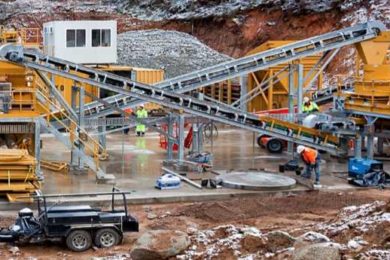CSIRO has been working with Barrick Gold at its Goldstrike plant in Nevada, to produce its first ever gold bar that doesn’t involve the use of cyanide extraction. Cyanide is, of course, highly toxic and a potential environmental hazard. The new process CSIRO is so excited about uses thioshulphate, which will greatly reduce the environmental risks and costs associated with gold production. Thiosulphate has been researched for gold recovery for many years and is perhaps now closing in on widespread use.
CSIRO says “thiosulphate has long been seen as a potential alternative to cyanide for liberating gold from ores, but it has proved difficult to master – until now. Thanks to the new process, which incorporates patented technology developed with Barrick, the company will be able to process and profit from 4 Mt of stockpiled ore that was uneconomic to process by traditional methods.”
As part of the thiosulphate process at Goldstrike, gold-bearing ore is heated in large pressure chambers, autoclaves. The slurry of ore, air, water and limestone is then pumped into the new resin-in-leach circuit operating inside large stainless steel tanks.
Within the tanks, the slurry interacts with thiosulphate and the fine, bead-like resin that collects the gold. At full capacity, 13,400 t/d of ore can be processed daily, with leaching taking place simultaneously in two sets of seven tanks.
CSIRO minerals expert Danielle Hewitt had a hands-on role in developing and proving the CSIRO technology incorporated at the Goldstrike plant. “This was a golden moment more than 20 years in the making, including three years working with Barrick to refine the commercial process,” she said.
“It’s the culmination of years of hard work and a good example of how our partnership culture is manifesting itself on the ground,” said Goldstrike General Manager Andy Cole. “This was a huge initiative, and it would not have succeeded if it weren’t for the collaboration, trust and accountability that developed between our project team, CSIRO, the construction group and the Goldstrike operations team.”
The new process will contribute an average of 350,000 to 450,000 oz/y of extra gold to the operation.
Around the world, the new technology could have great benefits, with the potential to safely recover gold from deposits where cyanide would otherwise pose a significant environmental risk and environmental protection cost.
“Replacing cyanide with the non-toxic thiosulphate stands to reduce environmental risks and open other opportunities in countries where gold cyanidation is banned,” says CSIRO Team Leader for Gold Processing, Dr Paul Breuer. “Thiosulphate processes may also be viable for low-grade deposits or deep orebodies, where in situ recovery would be safer for workers and the environment.”









